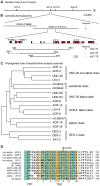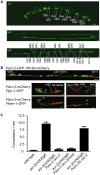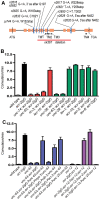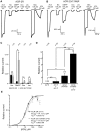A neuronal acetylcholine receptor regulates the balance of muscle excitation and inhibition in Caenorhabditis elegans
- PMID: 20027209
- PMCID: PMC2787625
- DOI: 10.1371/journal.pbio.1000265
A neuronal acetylcholine receptor regulates the balance of muscle excitation and inhibition in Caenorhabditis elegans
Abstract
In the nematode Caenorhabditis elegans, cholinergic motor neurons stimulate muscle contraction as well as activate GABAergic motor neurons that inhibit contraction of the contralateral muscles. Here, we describe the composition of an ionotropic acetylcholine receptor that is required to maintain excitation of the cholinergic motor neurons. We identified a gain-of-function mutation that leads to spontaneous muscle convulsions. The mutation is in the pore domain of the ACR-2 acetylcholine receptor subunit and is identical to a hyperactivating mutation in the muscle receptor of patients with myasthenia gravis. Screens for suppressors of the convulsion phenotype led to the identification of other receptor subunits. Cell-specific rescue experiments indicate that these subunits function in the cholinergic motor neurons. Expression of these subunits in Xenopus oocytes demonstrates that the functional receptor is comprised of three alpha-subunits, UNC-38, UNC-63 and ACR-12, and two non-alpha-subunits, ACR-2 and ACR-3. Although this receptor exhibits a partially overlapping subunit composition with the C. elegans muscle acetylcholine receptor, it shows distinct pharmacology. Recordings from intact animals demonstrate that loss-of-function mutations in acr-2 reduce the excitability of the cholinergic motor neurons. By contrast, the acr-2(gf) mutation leads to a hyperactivation of cholinergic motor neurons and an inactivation of downstream GABAergic motor neurons in a calcium dependent manner. Presumably, this imbalance between excitatory and inhibitory input into muscles leads to convulsions. These data indicate that the ACR-2 receptor is important for the coordinated excitation and inhibition of body muscles underlying sinusoidal movement.
Conflict of interest statement
The authors have declared that no competing interests exist.
Figures







Similar articles
-
ACR-12 ionotropic acetylcholine receptor complexes regulate inhibitory motor neuron activity in Caenorhabditis elegans.J Neurosci. 2013 Mar 27;33(13):5524-32. doi: 10.1523/JNEUROSCI.4384-12.2013. J Neurosci. 2013. PMID: 23536067 Free PMC article.
-
Neuropeptides function in a homeostatic manner to modulate excitation-inhibition imbalance in C. elegans.PLoS Genet. 2013 May;9(5):e1003472. doi: 10.1371/journal.pgen.1003472. Epub 2013 May 2. PLoS Genet. 2013. PMID: 23658528 Free PMC article.
-
Novel Mutations in Synaptic Transmission Genes Suppress Neuronal Hyperexcitation in Caenorhabditis elegans.G3 (Bethesda). 2017 Jul 5;7(7):2055-2063. doi: 10.1534/g3.117.042598. G3 (Bethesda). 2017. PMID: 28468816 Free PMC article.
-
C. elegans Locomotion: Finding Balance in Imbalance.Adv Exp Med Biol. 2018;1112:185-196. doi: 10.1007/978-981-13-3065-0_14. Adv Exp Med Biol. 2018. PMID: 30637699 Review.
-
Functional genomics of the nicotinic acetylcholine receptor gene family of the nematode, Caenorhabditis elegans.Bioessays. 2004 Jan;26(1):39-49. doi: 10.1002/bies.10377. Bioessays. 2004. PMID: 14696039 Review.
Cited by
-
A genome-wide RNAi screen in Caenorhabditis elegans identifies the nicotinic acetylcholine receptor subunit ACR-7 as an antipsychotic drug target.PLoS Genet. 2013;9(2):e1003313. doi: 10.1371/journal.pgen.1003313. Epub 2013 Feb 28. PLoS Genet. 2013. PMID: 23468647 Free PMC article.
-
Double mutation of open syntaxin and UNC-18 P334A leads to excitatory-inhibitory imbalance and impairs multiple aspects of C. elegans behavior.bioRxiv [Preprint]. 2023 Nov 10:2023.08.18.553709. doi: 10.1101/2023.08.18.553709. bioRxiv. 2023. PMID: 37645974 Free PMC article. Preprint.
-
Asynchronous Cholinergic Drive Correlates with Excitation-Inhibition Imbalance via a Neuronal Ca2+ Sensor Protein.Cell Rep. 2017 May 9;19(6):1117-1129. doi: 10.1016/j.celrep.2017.04.043. Cell Rep. 2017. PMID: 28494862 Free PMC article.
-
ACR-12 ionotropic acetylcholine receptor complexes regulate inhibitory motor neuron activity in Caenorhabditis elegans.J Neurosci. 2013 Mar 27;33(13):5524-32. doi: 10.1523/JNEUROSCI.4384-12.2013. J Neurosci. 2013. PMID: 23536067 Free PMC article.
-
Kinesin-3 mediated axonal delivery of presynaptic neurexin stabilizes dendritic spines and postsynaptic components.PLoS Genet. 2022 Jan 28;18(1):e1010016. doi: 10.1371/journal.pgen.1010016. eCollection 2022 Jan. PLoS Genet. 2022. PMID: 35089924 Free PMC article.
References
-
- Lindstrom J. Structures of neuronal nicotinic receptors. In: Clementi F, Fornasari D, Gotti C, editors. Neuronal nicotinic receptors. Berlin (Germany): Springer; 2000. pp. 101–162.
-
- Karlin A. Emerging structure of the nicotinic acetylcholine receptors. Nat Rev Neurosci. 2002;3:102–114. - PubMed
-
- Unwin N. Refined structure of the nicotinic acetylcholine receptor at 4A resolution. J Mol Biol. 2005;346:967–989. - PubMed
Publication types
MeSH terms
Substances
Grants and funding
LinkOut - more resources
Full Text Sources
Other Literature Sources
Molecular Biology Databases
Research Materials

